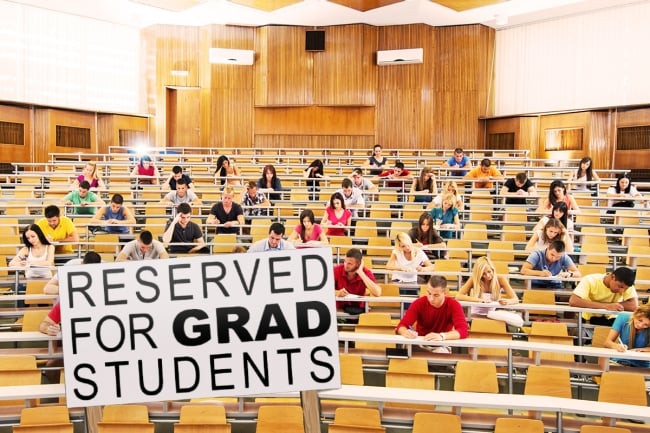You have /5 articles left.
Sign up for a free account or log in.

Enrollment in graduate programs fell sharply in 2022, even as applications surged.
Photo Illustration by Justin Morrison/Inside Higher Ed | Getty Images
Enrollment in graduate and postgraduate programs declined from 2021 to 2022 even as the number of applications increased, according to a new report from the Council of Graduate Schools.
Applications to graduate programs rose by 3.9 percent over all, a bump that was buoyed by especially sharp growth at institutions exclusively offering master’s degrees, which saw an 18.8 percent increase in applications, and doctoral programs at R-2 institutions (those with “high research activity”), which saw 10.4 percent more applicants.
But fall 2022 enrollments were down 4.7 percent over all, a sharp decline particularly striking when compared to the application boost. Doctoral programs at R-1 universities saw a 6 percent drop, and medical and other professional program enrollment fell by around 2 percent each. Enrollment in graduate programs at master’s-level colleges and universities rose by 2.5 percent.
The downturn in graduate enrollment is a reversal of an uptick during the pandemic, when enrollment grew by 1.8 percent in 2020 and again by 8.9 percent in 2021. The report’s authors declined to speculate on the state of graduate enrollments in 2023, citing a lack of available data. The National Student Clearinghouse Research Center should have data on fall 2023 enrollment in the coming weeks.
Brian McKenzie, one of the report’s authors and director of research at the graduate council, said the report was an indicator of the graduate degree sector’s relative stability, despite the decline. He speculated that the reason for the discrepancy between applications and enrollment had more to do with a tight job market than with declining interest in graduate-level education.
“Demand for these degrees is still high, and business is good,” he said.
At the same time, the report’s authors say the data suggest the graduate degree market is being rocked by the same forces eating away at undergraduate enrollment: a strong post-pandemic economy, perceived lack of opportunity for underrepresented groups and general disillusionment with the cost and value of postsecondary education.
“In the long term, it’s a troubling sign that slowing enrollment growth and the challenges facing the higher education sector as a whole, like the demographic cliff and competition from the job market, are starting to trickle down to the graduate level,” McKenzie said.
A Mixed Bag
In 2020 and 2021, graduate enrollment surged despite a 34 percent drop in international grad student enrollment at the outset of the pandemic. In 2022 the opposite was true: international enrollment increased by 10 percent despite the overall dip, bringing the total proportion of international graduate students in the U.S. to 21.9 percent—a 3 percent increase from 2021—and helping to make up for a 9.6 percent decline in domestic enrollment.
Enrollment in doctoral programs decreased by 3.2 percent from 2021 to 2022, perhaps indicative of a growing sense of fatalism about the job-prospect benefits of pursuing higher-level doctoral studies.
“It could be that there’s institutional pressure to limit Ph.D. cohort sizes as individual stipends increase,” said Julia Kent, CGS’s vice president of best practices and strategic initiatives. “But there’s also been a lot of discussion in the press about pressure on the academic job market, and it’s certainly possible that has shaped prospective Ph.D. students’ ideas about the value of that degree.”
Nearly three-quarters of total graduate enrollments were in master’s programs, while 25.5 percent were in doctoral programs. The three fields of study with the largest share of graduate degree seekers were business, health sciences and education; the latter also had the largest proportion of part-time students.
Other significant findings included in the report:
- Only mathematics and computer science programs saw a general increase in enrollment—of 5.4 percent—from 2021 to 2022. The most pronounced declines were in engineering graduate degrees, where enrollment fell by over 8 percent.
- First-time graduate students in fall 2022 were disproportionately white and female: 56.7 percent were white, and 57.8 percent were women. But enrollment for white graduate students has been on a slow but steady 10-year decline, which only became more pronounced in 2022 with an 11 percent drop in white enrollment.
- Enrollment fell among underrepresented racial groups: by 7.8 percent among Black students, 5.7 percent among Latinx students and 1.2 percent among Native American students. This disparity could be even harder to overcome going forward, now that race-conscious admissions practices are illegal.
- Graduate enrollment of Asian students also declined sharply, by 8.8 percent—despite being the only racial group to increase from 2020 to 2021.
- The number of graduate-level certificates awarded fell by 1.2 percent, reflecting a growing bifurcation of the institutions choosing to offer them. The majority of certificates were in three fields—health sciences, education and engineering—awarded largely by R-2 universities, which saw an 8.1 percent increase in certificate attainment. The number of certificates from R-1 universities, however, dropped by 7.6 percent. Still, the certificate market has grown by over 10 percent from 2016–17 to 2021–22.
- Part-time graduate enrollment decreased by 6.9 percent, nearly twice as much as for full-time programs.
- Total graduate enrollment at public institutions increased slightly, by 0.2 percent, while decreasing by 1.6 percent at private nonprofit institutions.
Rising Tide, Sinking Ships
Chris Connor, assistant dean for graduate education and chief enrollment officer at the State University of New York’s University at Buffalo, said that in his institution’s case, declining enrollments could be considered a kind of corrective for the surge in graduate enrollment in 2021.
“During [the pandemic] in 2020, much of that applicant pool was forced to defer to fall 2021, so there was all this bleed-over,” he said. “We made a conscious decision, because of the explosive growth in 2021, to lower the number of offers that we had in fall 2022 and even in fall 2023 to make sure that faculty hiring could catch up to the pace of enrollment growth.”
Connor also said the discrepancy could be the result of some growing pains, as institutions of higher education increasingly recalibrate their graduate offerings to meet workforce demands—a change in focus he says he’s noticed since the pandemic exacerbated concerns about undergraduate enrollment trends.
“Institutions are now really forced to look at graduate enrollment as part of the institutional strategic enrollment plan,” he said. “Four-year degrees have gone down as demographic declines set in, and so graduate enrollment will be more important.”
McKenzie said that to truly capitalize on that demand and reverse the nascent graduate enrollment slide, institutions and government officials should push for reforms to ease the ballooning debt burden of graduate students and open up the doors of postgraduate education to more low- and middle-income students.
Among his suggestions: an influx of funding for graduate retention efforts and career services, expanding Pell Grant eligibility to graduate students, and actively recruiting older adult and other nontraditional students to graduate programs.
“These slowing enrollment trends that we are beginning to see trickle into graduate education, that is unfortunately the current moment,” he said. “But it’s also an opportunity for the federal government, institutions and employers to come together as partners and make graduate education more accessible.”









